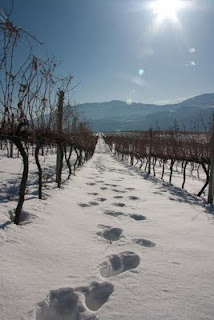Many of you know the immense respect I have for organic farmers (of all varieties). Organic farming is a real and genuine commitment to the land (and the consumers) to treat it with respect and approach it with some level of understanding.
How much more then, can I say for bio-dynamic viticulture? Or wineries who adopt zero-carbon emission standards, or make efforts to dramatically reduce their carbon footprint? The obvious answer is that I have the utmost respect for any business person who makes the effort, who takes the time to address our immediate and growing concern of limited resources on this planet and too few people grabbing at what there is.
I had thought that our government in British Columbia was forward thinking enough to share these sentiments.
Perhaps I was wrong.
 |
| Ezra Cipes, general manager |
Summerhill Pyramid winery (www.summerhill.bc.ca) is a true destination-location in the south Okanagan Valley DVA. Stephen Cipes first came to this region in 1986 and felt that he had found the place to call home for himself and his family. 35 years later, the family has bound itself to the land and says categorically that they are lucky to be able to do so. Ezra Cipes, Stephen's son says:
"At Summerhill we have so much to celebrate. The quality of wine, food, and service that we are known for, and the good conscience we share knowing the care that goes into our products, truly brings us together as a family. I spend a lot of my life at work, and the love and friendship I share with the team at Summerhill helps me feel whole and like my life is well lived."
So knowing these sentiments from the Cipes family, knowing that they have worked diligently on their organic certification for all of the farms who provide the winery with it's grapes and also work towards bio-dynamic certification... knowing all of this and knowing the vast array of awards that have been earned by these craftsmen I was well and truly stunned to learn this month (August 2011) that the winery will be losing it's VQA status on one of their wines.
Why? What terrible thing could Summerhill have done?
They created a 3-Litre box for their wine.
Oh the (mock) horror of it all~! It's clearly stated in the province's Agricultural Food Choice and Quality Act, only bottled wine can be VQA. Never mind that Summerhill is using the exact same wine that goes into their bottles, or that there is a 76% reduction in the carbon footprinting vs bottles and corks for that same volume.
 |
| Stephen Cipes, owner |
Just never mind.
...
Well actually I do mind. And so should you.
When business-people make the time and take the effort to be environmentally responsible, without encouragement from the government, we the people should be cheering them on~! The government should make a point of recognizing forward-thinking rather then castigating it.
But I imagine that Stephen Cipes and his family will continue to do what they do, and do it in their responsible and conscientious manner. They will continue to be the most-visited winery in Canada, and will continue to take their wines around the world garnering recognition from winemakers and sommeliers where-ever they go. They will continue to do business as they see fit, though without the support of the body that has the most reason to be supportive: when a single BC winery is this pro-active and produces this level of quality, it is the entire BC wine industry that gains standing in the global arena.
2007 Summerhill Pyramid winery small lot Cabernet Franc
Okanagan Valley DVA, British Columbia
$28.95 @ the winery
92+ points
93 points - Best of Class, Gold Medal - Los Angeles International Wine and Spirit Awards 2011
450 cases produced
- visual: clear with trace sediment; medium+ to fully intense bruised plum core with slight cherry and slightly brick rim
- nose: clean; medium+ to fully intense developing bouquet of red and black raspberries, red and black currants, old worn leather, slight savory herbs such as thyme, traces of drying summer flowers and pink peppercorn
- palate: clean; medium+ (lively red currant) acids, medium+ (slightly chalky and well integrated) tannin, medium body, medium ABV, medium+ to fully intense and developing flavors mimicking the nose with emphasis on the red berry flavors opening the palate; dark berries are still developing; excellent balance and structure with long length
- conclusion: an excellent display of Okanagan terroir and the Cabernet-Franc varietal; drinking well now this wine will cellar for years and develop slightly in bottle over the next 24 months. Enjoy 2011-2016+
- FOOD PAIRINGS: the acids on this are very, very well balanced and as such have no need of excess fats. Consider a butter glazed beef tenderloin with grilled leeks and sweet-pea risotto
The plantings of Cabernet Franc come from Knollvine farms in the Okanagan Falls region. Summerhill was instrumental in many vineyards achieving their organic certification and after this beautiful showing, I look forward to sampling more of the honest work behind Canada's most-visited winery.
As always, I welcome your questions and comments.
CINCIN~!!! SLAINTE~!!! CHEERS~!!!
















